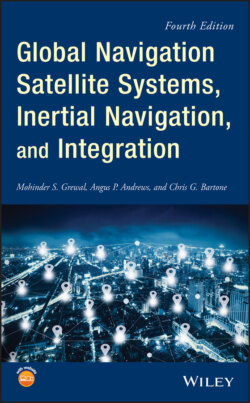Читать книгу Global Navigation Satellite Systems, Inertial Navigation, and Integration - Mohinder S. Grewal - Страница 42
1.3.1.2 Development Challenges: Then and Now
ОглавлениеThe technology of Newton's time was not adequate for practical implementation. What was missing included the following:
1 Methods for measuring three components of the acceleration vector a(t) in Eq. (1.1) with sufficient accuracy for the navigation problem.
2 Methods for maintaining the representation of vectors a(t) and v(t) in a common inertial coordinate frame for integration.
3 Methods for integrating a(t) and v(t) in real time (i.e. fast enough for the demands of the application).
4 Methods for initializing v(t) and x(t) in the common inertial coordinate frame.
5 Applications to justify the investments in technology required for developing the necessary solutions. It could not be justified for transportation at the pace of a sailing ship or a horse, but it could (and would) be justified by the military activities of World War II and the Cold War.
These challenges for inertial navigation system (INS) development were met and overcome during the great arms races of the mid‐to‐late twentieth century, the same time period that gave us GNSS. Like GNSS, INS technology first evolved for military applications and then became available for consumer applications as well. Today, the same concerns that have given us chip‐level GNSS receivers are giving us chip‐level inertial navigation technology. Chapter 3 describes the principles behind modern‐day inertial sensors, often using macro‐scale sensor models to illustrate what may be less obvious at the micro‐scale. The following subsections provide a more heuristic overview.
